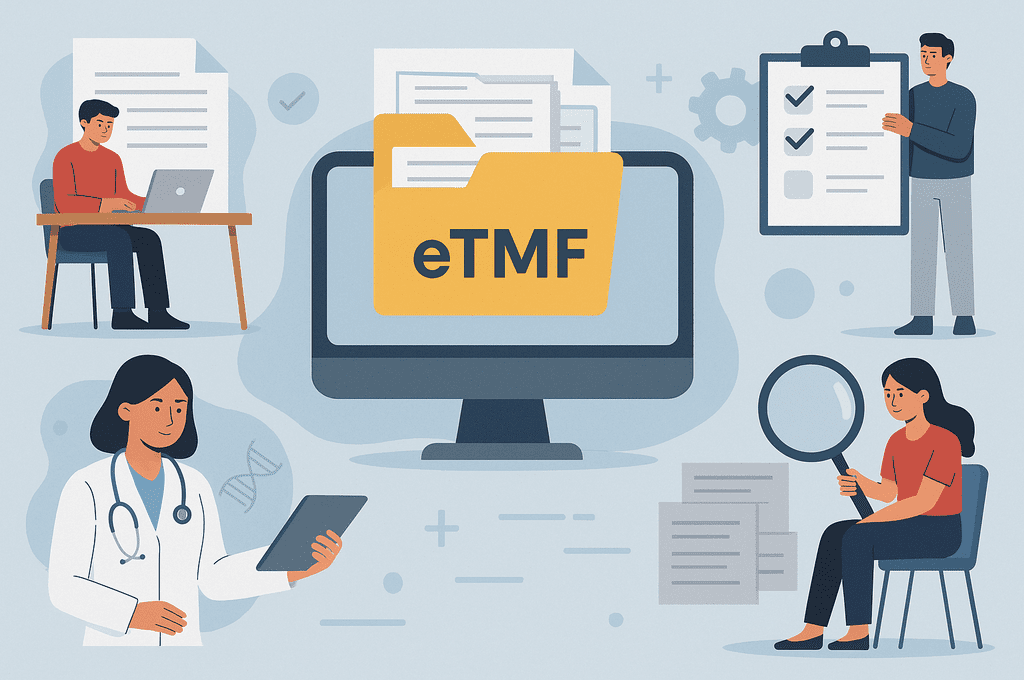The acronym eTMF stands for "Electronic Trial Master File". Several well-established clinical trials utilize this system all around the world to manage, organize, and keep track of extensive trial-related papers and data.
eTMF is significant because it guarantees that all trial-related records are safe, easily retrieved, trackable, and, most all, compliant—a crucial component of good clinical practice (GCP), which is mandated by regulatory bodies like the FDA.
A real-time transparency system that can swiftly detect whether papers are missing or a product that has expired can enable the research team to swiftly address those gaps and continue forward as the clinical trial programs grow and advance.
The Security of Every Record Is Dependent on eTMF Systems, Which Allow Relevant Parties to View, Edit, and Verify Them at Any Time:
All parties participating in the trial may see, edit, and confirm all papers, records, and reports using eTMF, a secure database. Information about sponsored trials is kept there from the time of registration until the end.
eTMF solutions, which use blockchain technology, can be developed internally by companies or implemented by hosting providers based on the demands of the latter. Among the characteristics are:
- A single, central database containing all eTMF system data
- password security to prevent access by unauthorized users
- auditing features that let you monitor who has access to your data at all times
Electronic records are kept in a secure network that is only accessible to those who have permission to do so:
Only authorized users can access the secure network where your data is electronically stored. This guards against manipulation and guarantees the accuracy of your data. Clinical trials are frequently drawn-out, time-sensitive procedures, thus this is significant.
Put differently, the following tasks may be accomplished with the help of an eTMF system:
- Keep all of your private and sensitive materials (such as clinical trial procedures) accessible only to those who are authorized to see them.
- Securely distribute these documents around your team members so they may work on them without fearing that their effort will be lost if the document has already been altered or amended by someone else.
- Make sure that all of the documentation related to each patient's clinical trial participation is safe.
Throughout the clinical trial process, there are a number of points when gathering documentation, recording data, and then verifying that data are necessary:
Multinational pharmaceutical corporations and contract research organizations (CROs), such as Vial, typically employ electronic prototype factories (eTMFs) to help the life sciences sector by contracting out research activities. Among the important documents gathered are:
- CTMF (Clinical Trial Master File) Guidelines and Practices Instruction manuals
- Brochures for Investigators
- Reports on the Monitoring Plan
- Reports on Data Validation
- Reports on Audits
- Forms for Participant Informed Consent
- Results of Lab Tests Scanned Pictures of Records
- Forms for electronic case reports
Authorized users can access the eTMF from any internet-connected computer. At every stage of the clinical trial process, including submission planning, regulatory submissions, operational management, budgeting, costs savings analysis, statistical analysis, risk assessment, patient recruitment, data collection, real-time study activities, and reporting of findings, this enables the timely retrieval of information to support decision-making.
Simplifying every facet of clinical trial documentation management is the aim of an eTMF. By doing this, you may lower the time spent looking for and verifying paperwork, lower the overall cost of medication research, and improve trial efficiency.
Agility and Site Monitoring are Both Possible with an eTMF
An eTMF also facilitates site monitoring, allowing modifications to be documented during a study in the event that something occurs that calls for more investigation, such an unfavorable incident or a protocol modification made after approval.
Every record every piece of collectible data is kept consistent by the eTMF
The eTMF can help your organization with three primary functions:
- Data Capture (Data Entering): Electronic records may be entered into a single central database using the eTMF as a single source. Patient data, demographics, medical history, and therapies received are all included in these records. You won't have to be concerned about data entry errors or data loss from many sources when you have an eTMF in place.
- Document Management (Document Tracking): With the eTMF, you can keep track of all the documents that are associated with a study, including orders, receipts, and invoices that are connected to research activities (including site modifications). This guarantees that nothing is overlooked and eliminates the possibility of crucial data being forgotten or lost between departments or individuals doing research at various locations throughout the globe!
- Document archiving (archived content): The eTMF needs a reliable method for keeping the vast amounts of clinical trial master file material accessible and readily available for at least 25 years. Maintaining the data for decades to come might become expensive for an organization as the number of historical and ongoing clinical studies increases. Consequently, it is necessary to test archived eTMF access on a regular basis.
Conclusion
Because eTMF makes it simpler for all trial participants to access and validate information, it has contributed to the efficiency and security of clinical trials. Because nothing is kept on paper—rather, everything is maintained electronically—errors are likewise reduced.
In the end, this enhances the quality of life for patients waiting for new medications by guaranteeing the integrity of clinical studies
Octalsoft's eTMF software solution provides a digital platform and strategy for electronically capturing, organizing, sharing, and storing all critical documents, photos, and artifacts that develop over the course of a regulated clinical trial. The system includes the DIA TMF Reference Model, which enables users to organize their content according to a known taxonomy and structure. Built-in checklists and milestone tracking capabilities enable you to actively assess the completeness and compliance of any material in real time.
Learn even more about Octalsoft eTMF here. Do you have questions or are curious about how to leverage it in your studies?



